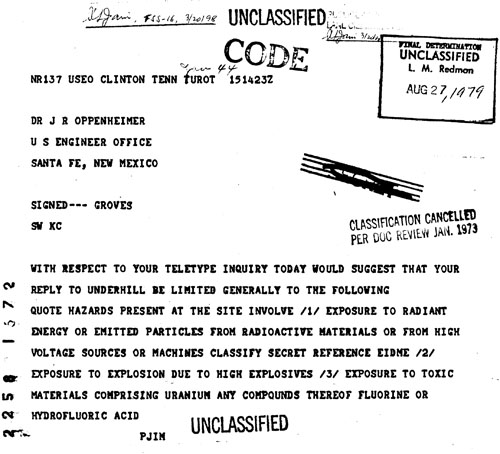Nuclear technology has had an odd relationship to insurance in the United States. Why? Because it is high-risk, low-probability technology — no underwriter wants to contemplate insuring against a full meltdown disaster, as rare as they are. The result of this is that in the United States, under the 1957 Price-Anderson Nuclear Industries Indemnity Act, the American public essentially acts as the underwriters for all nuclear power plants. It’s an arrangement that is understandably controversial amongst a diverse group of critics.
But the history of odd nuclear insurance arrangements dates back much earlier.
In December 1942, the University of California agreed, at the insistence of J. Robert Oppenheimer and Ernest O. Lawrence, to become the manager of the secret Los Alamos laboratory. Well, in truth, they agreed to manage some kind of laboratory — they didn’t know it was at Los Alamos. They didn’t even know what state it was in, much less what it was supposed to be doing. As manager, their job was to procure supplies and manage personnel employment.1
And, as a consequence, purchase insurance for the lab. Which is one of many things that made the UC’s secretary and finance officer, Robert Mackenzie Underhill, unhappy. Because what prudent finance officer would let such a project be uninsured against hazards? But it’s awful hard to find insurance when you don’t know where the project is much less what is to be insured against.

Robert M. Underhill: the UC’s financial watchdog, and the only Regent who knew about the bomb.
The amazing fact is, nobody in the UC management hierarchy had a clue what they were doing at this secret lab. It was really that secret. In February 1943, Underhill had finally managed to weasel out of the Army that the secret physics project was in New Mexico — so that they could purchase insurance for it.
It was not until November 1943 — nearly a year after the UC had taken on management responsibilities — that Ernest Lawrence decided it was necessary to let Underhill just a teensy bit in on the secret. Not because Lawrence cared too much what Underhill thought, but because he felt it might expedite Underhill’s activity (and general financial conservatism) if the latter considered the program an important undertaking.
In Underhill’s recollection, Lawrence went to Underhill’s office, locked the door, and pulled down the curtains. Lawrence asked him, “You know what they’re doing down in Los Alamos?” Underhill said no — he knew only that Oppenheimer was running a “scientific study in physics.” Lawrence then filled him in that the UC was now thoroughly enmeshed in the production of atomic bombs. Amazingly, Underhill remained the only top UC official to know the purpose of the project; even the UC President, Robert Sproul, was not filled in. (And in fact, he got in trouble later in the war for speculating publicly that they were working on a death ray — a little too close to the truth, as it turned out.)
This week’s document is a teletype from General Groves to Oppenheimer from February 1944, instructing the latter as to what to tell Underhill about the hazards to be insured against at an unspecified site.2
The “hazards present at the site,” Groves told Oppenheimer to relate to Underhill, involve:
- Exposure to radiant energy or emitted particles from radioactive materials or from high voltage sources or machines “classify secret reference eidme” (I am not sure what this last bit means, other than perhaps to say that item #1 here is classified secret)
- Exposure to explosion due to high explosives
- Exposure to toxic materials comprising uranium [and?] any compound thereof fluorine or hydrofluoric acid
From the context, I would think the site was Los Alamos — high explosives, radiation, uranium. February 1944 seems a little late to be specifying this sort of thing, but it may either be a sub-site of Los Alamos, or they might just be back-dating things.

Norris Bradbury (L) and Robert Underhill (R), signing the UC lab management contract renewal in 1952.
Underhill is a curious figure in the history of the bomb. He saw the whole enterprise as a dubious matter for the UC to be tied up in, and shows up at various junctures trying to protect the UC’s financial and legal interests. That the UC would have and be able to act on its own financial and legal interests in this situation — and not just roll over at the request of the Army — is what I find so interesting about these little episodes.
It’s common to see the bomb as this immovable, in-opposable force in American life and politics, but there are all sorts of little compromises that had to be made, especially in the early days, to get it off the ground.
- The best one-stop shop for information about the early involvement of the University of California in management of Los Alamos and later Livermore is Gregg Herken, “The University of California, the Federal Weapons Labs, and the Founding of the Atomic West,” in Bruce William Hevly and John M. Findlay, eds., The Atomic West (Seattle, Wash.: University of Washington Press, 1998), 119-135. The change-over from UC management to privatized management in the early 2000s was quite controversial; Hugh Gusterson’s recent article in BAS, The assault on Los Alamos National Laboratory: A drama in three acts, is a must-read on the current management situation. [↩]
- Citation: Teletype from Leslie R. Groves to J. Robert Oppenheimer (January 1944), copy in Nuclear Testing Archive, Las Vegas, NV, document NV0317507. [↩]




The information to be given to the insurers seems very informative. Could it really have been intended to be released?